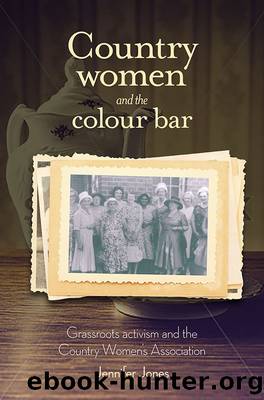Country Women and the Colour Bar by Jennifer Jones

Author:Jennifer Jones [Jones, Jennifer]
Language: eng
Format: epub
Tags: Social Science, Women's Studies
ISBN: 9781925302967
Google: z2wJswEACAAJ
Publisher: Aboriginal Studies Press
Published: 2015-01-15T04:20:10+00:00
CopmanhurstâBaryulgil CWA and the constraints of working-class membership
Membership of the CopmanhurstâBaryulgil CWA Branch suggests that the long-held desire for racial segregation at Baryulgil was substantially unchallenged by the CWAâs attempt to foster social mixing. No white women from the Baryulgil district joined the branch; instead, white women were attracted from working-class farming communities at Copmanhurst and Coaldale located about thirty kilometres north and northeast of Grafton. Copmanhurst was then a small service centre for surrounding cattle stations and small-scale dairy farms.37 The willingness of white women from Copmanhurst and Coaldale to join Aboriginal women in the new CopmanhurstâBaryulgil CWA Branch made it the first âAboriginalâ branch to have a balanced and sustained membership of Aboriginal and white women from the same district.
CopmanhurstâBaryulgil CWA was the fifth Aboriginal branch established by the CWA of NSW. State president Thelma Bate announced the new venture at a meeting of the North Coast Group on 3 April 1962:
By the time you read this we will have another Branch in an aborigine settlement â this time at Copmanhurst on the North Coast. So many undesirable pressures are brought to bear on our coloured people, by those who want to organise them into a militant minority group that it is a great joy to know that we are making a positive contribution for good.38
Rather than displaying susceptibility to âmilitant minority groupsâ, the Aboriginal women from the Copmanhurst district were instead keen to display their capability as the organisers rather than the organised.
Aboriginal women were still fighting for recognition of their capacity to occupy womenâs traditional roles in the home and the private sphere. Mrs Doris Swan, a CWA member who had âclose contactâ with Aboriginal people, advocated for the opening of a new CWA branch at CopmanhurstâBaryulgil âfor aborigines in the districtâ.39 Mrs Swan attested to the âreliability, integrity and capabilitiesâ of the prospective Aboriginal CWA members to âtake officeâ:40
The display of handicraft prepared for the opening was evidence of their intention to make this a success. There was shell-work, crochet, preserves and many articles of clothing beautifully made. They have amongst them a pianist and their own handicraft officer. In addition they had even raised money for a starter.41
Aboriginal women from the CopmanhurstâBaryulgil district not only stood for election for president, secretary and treasurer, but also took on the demanding position of handicraft officer. One of the first activities of the branch was to donate âattractiveâ shell-worked boxes to a Grafton CWA stall, raising funds for the Association of Country Women of the World (ACWW).42 Exhibiting skills in womenâs traditional activities including crochet, preserving fruit, sewing, piano and philanthropy, the new members impressed their fellow white CWA stalwarts, who now expected much of the new collaboration. Records suggest, however, that the class differences of Aboriginal and white members at CopmanhurstâBaryulgil limited the capacity of both groups to engage in the full gamut of CWA activities.
After the new Aboriginal CWA branch settled into a routine of monthly meetings and craft activities, including cake decorating, smocked cushion making and games afternoons, the members addressed their pressing need for funds.
Download
This site does not store any files on its server. We only index and link to content provided by other sites. Please contact the content providers to delete copyright contents if any and email us, we'll remove relevant links or contents immediately.
| Africa | Americas |
| Arctic & Antarctica | Asia |
| Australia & Oceania | Europe |
| Middle East | Russia |
| United States | World |
| Ancient Civilizations | Military |
| Historical Study & Educational Resources |
Cecilia; Or, Memoirs of an Heiress — Volume 1 by Fanny Burney(32064)
Cecilia; Or, Memoirs of an Heiress — Volume 3 by Fanny Burney(31459)
Cecilia; Or, Memoirs of an Heiress — Volume 2 by Fanny Burney(31409)
The Secret History by Donna Tartt(18168)
Sapiens: A Brief History of Humankind by Yuval Noah Harari(13993)
Leonardo da Vinci by Walter Isaacson(12807)
The Radium Girls by Kate Moore(11624)
Sapiens by Yuval Noah Harari(5125)
How Democracies Die by Steven Levitsky & Daniel Ziblatt(4965)
The Wind in My Hair by Masih Alinejad(4847)
Homo Deus: A Brief History of Tomorrow by Yuval Noah Harari(4691)
Endurance: Shackleton's Incredible Voyage by Alfred Lansing(4508)
Man's Search for Meaning by Viktor Frankl(4292)
The Silk Roads by Peter Frankopan(4275)
Millionaire: The Philanderer, Gambler, and Duelist Who Invented Modern Finance by Janet Gleeson(4105)
The Rape of Nanking by Iris Chang(4024)
Hitler in Los Angeles by Steven J. Ross(3800)
The Motorcycle Diaries by Ernesto Che Guevara(3788)
Joan of Arc by Mary Gordon(3786)
